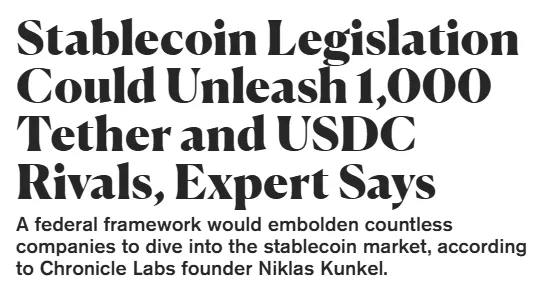Are you ready for a stablecoin explosion?
This is what is predicted for 2025. With the expected passage of stablecoin legislation, we could see competition in the sector heat up. This means that Circle and Tether are going to see their industry get crowded.
So far, corporations are on the sidelines, at least within the United States. Over the years, we heard about a variety of companies bringing out their own stablecoin. PayPal and Sony are two such examples. Then we have firms such as Blackrock bringing oult ones for institutional use.
It is likely that this is a drop in the bucket compared to what we are about to see.
The question is whether people are ready for this?

A World With Thousands Of Stablecoins
This is something that we discussed in the past. The barrier that stems from a lack of regulatory clarity could be ending.
Senate Banking Committee Chairman Tim Scott (R-SC) vowed this month that a stablecoin bill, dubbed the GENIUS Act, will be passed by both chambers of Congress and signed into law within the first 100 days of President Donald Trump’s administration.
With the passage of this, the United States would finally have some regulatory clarity with regards to stablecoins. It would allow any corportion to enter, understanding the rules surrounding this. What this means is that anyone who has payments on their platform could issue their own stablecoin.
Meta. Apple. Uber. Google. Home Depot.
Tokenization would be upon us.
“As soon as this legislation passes, there are going to be 10,000 companies looking at this,” Kunkel said. “I would expand that beyond just payment companies and asset issuers. [...] You can include tech companies: the Amazons, Ubers, Metas and Googles of the world."
Among interested firms, Kunkel bet 1,000 of them would debut a stablecoin within the following year that stablecoin legislation is passed. In lieu of adopting an existing stablecoin like Circle’s USDC, however, Kunkel said firms will be incentivized to release their own equivalent.
The stablecoin market is going to move from billions to trillions. Ultimately, we are going to see trillions in stablecoin units, most of then USD denominated.
At a time when the United States debt levels are hotly discussed, this adds an interesting point to the discussion.
US Tresury Demand And Free Money
Corporations are going to enter this because it is free money. This will be a boom to some of the larger platforms that amass billions within their stablecoin.
We can presume the regulation will require these coins to be asset backed. That means the holding of cash (US dollars) or investing in US Treasuries. This is the formula that Circle and Tether operate on.
If we follow the path, we see how these companies get free return.
A user brings a dollar to the platform. This is deposited and a stablecoin is generated. Now the company has a dollar which it uses to buy a T-Bill. The interest on this bond is paid to the company. The user has a stablecoin in his or her account, using that to transact.
Now imagine what a company like Meta could do with this.
That is why the expectation that thousands of companies will look into this. Leaving transaction fees aside, the interest on the bonds is a consistent flow of capital. Remember, this is not investing from company profits. It is currency (dollars) handed over by users or customers. Effectively, it is an interest free loan to the company.
The other factor is the impact on US Treasuries. If we get to the point where the stablecoin market is into the trillions, that will put the issuers of these coins as some of the largest holders of US debt. It was reported last year that stablecoin issuers were already the 18th largest holder of US debt.
What do these numbers look like when AI agents take over. As stated, crypto, specifically stablecoins, will be the medium of exchange in that realm.
US Dollar Dominance
The final factor is this will further cement the US dollar dominance.
One major advantage to the issuance of all these stablecoins is the ability to gain access. It is unclear where these will appear with regards to exchanges. However, there will be a few that are created as ERC-20 or some other protocol that is on public blockchains.
The result is a gateway from any currency into USD assets. Individuals can go from their native currency into one of these stablecoins, even if it means going through something else. There is a chance that using an application could provide the same ability.
This enhances the network effect of the US dollar. In this instance, there are dollars tied to the token, even if most of are US Treasuries. The situation shifts even further out when we consider algorithmic and nother non-asset backed (US) stablecoins.
We can see things really get hairy when USD denominated stablecoins which has no assets in dollars become plentiful. Here is where we see the USD as nothing more than a measurement.
It is rather ironic but the implementation of regulation could be what sets off a race to losing the ability to control and govern the stablecoin market.
There is a point where stablecoins could be part of a platform's (agent's) brand. It might end up being akin to a website.
In other words, they will be everywhere.